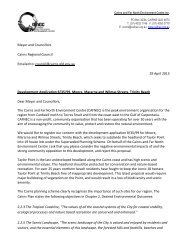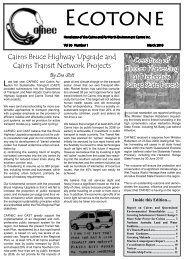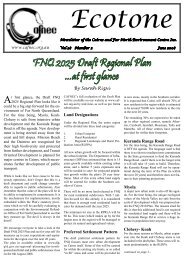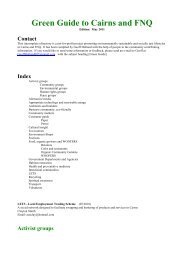Ecotone Vol32 No4 - CAFNEC
Ecotone Vol32 No4 - CAFNEC
Ecotone Vol32 No4 - CAFNEC
Create successful ePaper yourself
Turn your PDF publications into a flip-book with our unique Google optimized e-Paper software.
THE RIVER FLOWS TO THE REEF<br />
BY YVONNE CUNNINGHAM<br />
I have lived alongside the Johnstone River for forty-two<br />
years and watched the river run red every time heavy rain<br />
falls. Lately, I have noticed it needs less and less rainfall to<br />
cause the river to run red. (see Photo1)<br />
all coral cover. For some time there has been conclusive<br />
evidence to demonstrate the link between nutrient runoff<br />
and escalating crown-of-thorns starfish infestations.<br />
The evidence of the link between crown-of-thorns starfish<br />
outbreaks and nutrient run-off was first revealed at the<br />
Catchment-to-Reef conference in June 2004.<br />
I asked Martin Cunningham, a fisherman and my son,<br />
what is happening to the coral. Martin told me ’Coral<br />
along the headlands and around the inshore islands is<br />
gone. The fringing reefs are all but completely gone.<br />
Reefs 20 miles offshore are also in terrible shape. The near<br />
reef shoals such as Gouge Banks, Arthurs Patches and<br />
Surprise Shoal have a distinct red stain to the surrounding<br />
sediment and the coral cover would be less than ten per<br />
cent. The mid shelf reefs are in poor shape.’<br />
To investigate the cause of all this additional sediment<br />
that seems to be coming down the river these days I<br />
went with Victor Cassidy a local aboriginal Elder and keen<br />
fisherman, up the North Johnstone River. (see Photo 3)<br />
At the mouth of the Johnstone River the mangrove forest<br />
has died. It is thought that the sediments carried by the<br />
river contain many chemicals including herbicides. When<br />
these sediments are deposited, by the action of the river<br />
around the mangroves, herbicides slowly leach out and<br />
kill the mangroves. (see Photo 2)<br />
We left the town wharf and immediately saw riparian<br />
vegetation had been removed completely in front of<br />
some subdivisions along the river. Elsewhere gaps have<br />
been made in the vegetation to view the river. There was<br />
severe erosion on the riverbank adjacent to these riverside<br />
developments. (see Photo 4)<br />
The Australian Institute of Marine Science (AIMS) has<br />
reported the Great Barrier Reef has lost half its coral<br />
cover over the past 27 years. Much of the blame for coral<br />
loss has been placed on the effects of storms and coral<br />
bleaching. However, sediment and nutrient runoff from<br />
agriculture and coastal development are believed to have<br />
a far greater impact on the reef-ecosystem and affect the<br />
reef’s ability to naturally regenerate after storm events.<br />
One of the impacts of storms is the re-suspension of<br />
bottom sediments, reintroducing buried pollutants from<br />
earlier days.<br />
High background populations of crown-of-thorns starfish<br />
are reaching plague proportions every decade and are<br />
believed to be responsible for the loss of 42 per cent of<br />
10







